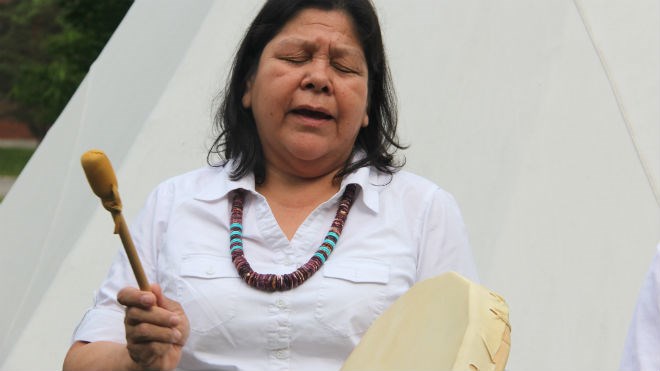When Hilda Nadjiwan was six years old, she was sent off to attend the Spanish Girls' School, a residential school for First Nations children.
She said her three years at the school were marked with abuse, and left her afraid to speak mother tongue.
When news reports about abuse in residential schools began to air, Nadjiwan said the first words she said were “That does not affect me.” But she eventually recognized just how deeply her life had been impacted.
“It affected me in all aspects,” said Nadjiwan, now a 72-year-old great-grandmother who lives in Sudbury. “Physically, emotionally, especially my spirit. My spirit was broken. I didn't realize how badly I was damaged.
“Especially in my young adulthood, I wondered what was wrong with me. I could not figure it out. I knew I came from a good home. But I thought 'What's wrong with me?' because I'd have outbursts of anger.”
Nadjiwan was invited to share her thoughts during a May 29 ceremony held at Laurentian University to mark the wrapping up of the Indian Residential Schools Truth and Reconciliation Commission of Canada.
Established in 2008 as part of the settlement agreement for residential school survivors, the commission heard the stories of survivors. The commission is due to release a summary of its final report June 2.
Although Nadjiwan didn't share her story with the commission, she said she thinks it was helpful, as it provided a venue for survivors to do just that.
During the Laurentian ceremony, Nadjiwan said she often thinks of those who didn't survive the experience of residential schools, as well as those who still lead lives of “quiet despair.”
“May we all be filled with much understanding, forgiveness, healing and peace, as we continue to all heal together,” she said.
While it's important to understand the legacy of residential schools, it's time to think about how to move forward, said Laurentian University president Dominic Giroux.
“It is a time to begin healing, respect and reconciliation,” he said. “It is a national opportunity to acknowledge Canada's past, and to come together as a country. It is time to chart a path for our future as a community of nations.”
Laurentian University is the site of a piece of history when it comes to the legacy of residential schools.
In the summer of 1986, officials with the United Church of Canada met at the university to hash out an apology for its involvement in residential schools, the first church to do so.
First Nations people had set up teepees in one of the university's parking lots to wait for the apology to be delivered. Today there's a rock cairn and plaque commemorating the occasion on the site.
Although the church has apologized, Aboriginal people said they wanted action, not just words.
“It's kind of kept our foot to the fire to be trying to live out those words,” said Will Kunder, executive secretary of the Manitou Conference of the United Church of Canada.
The topic holds special resonance for Kunder, who was the principal of a residential school in Yellowknife that closed in 1991. He said many people aren't aware residential schools closed relatively recently further north.
In terms of the Truth and Reconciliation Commission, Kunder said he hopes the forthcoming report isn't largely ignored like the Report of the Royal Commission on Aboriginal Peoples, released in 1996.
“My hope is that the TRC report and its call to action won't result in something collecting dust on a shelf somewhere,” he said. “I think all of us that care about this work worry about that.”
Join Sudbury.com+
- Messages
- Post a Listing
- Your Listings
- Your Profile
- Your Subscriptions
- Your Likes
- Your Business
- Support Local News
- Payment History
Sudbury.com+ members
Already a +member?
Not a +member?
Sign up for a Sudbury.com+ account for instant access to upcoming contests, local offers, auctions and so much more.
